G’day mates!
Greetings from Melbourne!
Today I’ve prepared an exciting series for you! Also, I’m flying to Tokyo next week. Send any Japan recommendations my way!
On the Agenda
(Lesson) Carving Your Destiny
(Personal) I’m Employed! 🥳
(Biz Update) The Perfect Investor
(Biz Update) Failed Intern Project
(Biz Update) Setting Up a Company
(Q&A) Engineering
(Q&A) Bonus
1. Carving Your Destiny
Happiness first. My personal wellbeing is best served when I feel like I have control over my own destiny.

Leo’s Portfolio - Snapshot (03/21)
Checking: $1,874.48
Roth IRA: $5,447.68
401K: $906.21
Total: $8,228.37
I’ve spent $31,626.20 in 7 months (average $4,518/mo). That leaves me with just under two months of runway left.
I’m worried that “being broke” will make me make poor decisions. Several times a day I get random flashes to start a bullsh*t freelancer business. It’s incredibly distracting. So far I’ve been able to resist this knee-jerk temptation— but reality is I need to enter a stable financial state ASAP. Cutting costs is a short-term fix and means sacrificing lifestyle. I’d rather focus my energy on increasing revenues. That means taking on a job, starting some sort of freelance business, or getting paid through Peers.
Society tells you two horrible pieces of career advice: (1) fail as often as possible and (2) you can become anything you want if you work hard and hustle enough. Believe either and you’re likely following the path of most resistance.
David has always been in the marble slab; Michelangelo just had to reveal the figure that was already there. Every blow of the chisel, every choice you make, shapes the type of person you will become. You’re both the creator and the created. You’re Michaelangelo and David. So bring out your chisel and start carving the masterpiece that is you!
What if you do what’s easy and fun? Lean into your natural talents? And have the self-awareness to know what you’re good at and not so good at so you can stop chasing those things. People fall into flow when they fall into who they already are. Resist the gravitational pull of society that leads you astray.
2. I’m Employed! 🥳
There are three ways to enter a club. Most everyone knocks on the front door. A few special people enter through the back door. And one clever guy climbs through the window!
I’ve had a topsy-turvy career path. I’m equally passionate about tech, art, and marketing. My friend says they couldn’t be more different.
Today I’m announcing a career transition! No resume, no interview, and no prior experience. Yes, I’m now in Influencer Marketing. “Senior Campaign Manager” at Delka Talents. 😎
I’ll explain influencer marketing through a real estate analogy. Imagine you want to buy a house. You’ll probably hire an agent. She’ll take you through the buying process and show you the houses that are right for you. Same thing for sellers. A seller’s agents lists the house and selects the appropriate buyers.
At Delka, we represent both the creators and brands. Other agencies might pick one side.
Our value proposition is simple. We tell creators to focus on what they do best. Making original content. Growing an audience and community. We’ll handle your finances and connect you with new opportunities / income sources.
Delka Talents is expanding its roster of creators and brands. My first task was to put together a list of YouTubers that we can work with. We look for a few things: 300k - 500k - 1m subscribers, consistently high engagement / views. The Creator Economy space is new so many creators aren’t represented, which means more opportunity for us.
Insert Excel screenshot
Why work with us? Creators may not know how to price themselves. Some brands will try to scam you by offering 20% of what you’re really worth. As a brand, you have your marketing budget. What’s the best way to deploy this capital to achieve your ‘KPIs’ or business goals (exposure, sales, awareness, trust)? Which influencers do I choose? What’s the right strategy? These are questions we’ll help you answer.
A typical workflow may look like this:
“Getting things done” is a game. You identify the decision-makers. Then you reverse-engineer a profile that fits their present desires. Let’s say you’re a Chief Marketing Officer. Would you like to work with a “World Traveler”? What about “Operations Director” or “VP of Development” or “Head of Marketing” or “Head of Brand”? That’s why my current LinkedIn title is “Senior Campaign Manager”, which I find hilarious. Day 1, and I don’t know what a “campaign” is yet I’m a “Senior Campaign Manager”. 😂
I’ve had a topsy-turvy career path. My peers go from ‘Software Engineer I → II → III’. I hopped from World Traveler to Writer to Tech Founder to (currently) in Influencer Marketing.
Building a Billion-Dollar Business Series 📺🍿
Leo is “Building a Billion-Dollar Business”® while doing his “One Year of Travel, New Year New Me”®. He is currently founding a technology startup which he hopes will be the largest in the world. Follow along!
Table of Contents
3. The Perfect Investor
Q: How do you find investors?
Well, the first answer is to browse open lists. You can find them online or on LinkedIn. For example, here’s a list of 154 India Investors and 683 US Investors.
A better strategy would be to look up specific people or funds who have invested in startups similar to your own. For example, you might look at Patreon (or its failed competitors) and look at all the investors who put money into it.
Of course, the best strategy is to ask within your network. Since I’m starting from zero, I know very few investors. But Gidon (my co-founder) knows some investors and even some relevant billionaires. That last option we’re keeping as a last resort as we’d rather bring them on in later rounds. 😎
We have a broad net. Our main priority is raising money at a good valuation. It’s not so important at this stage to be too picky with investors with strong connections. We’re open to investors from India and Southeast Asia as many of them would love the opportunity to invest in the US market but they don’t have the chance to do so.
The next step is to develop the market and test product-market fit. We are prioritizing fundraising because that is the most efficient path. To give you a sense of the numbers, I consulted with a development team. They offer a 1-yr service at $450k with ~6 senior developers (2 frontend, 4 backend). They can comfortably make an MVP in 6 months for $185k, and 4 months if push came to shove.
Q: Do we even need money?
That’s a great question and one we’re exploring. We technically already have an engineer on the team (👋 me) and I’m fully confident that I can learn the skills to build the app.
But I’m a bit weird. When I see somebody who can do a better job than I can — I instantly lose motivation to do that thing. I’ve already spoken with several seasoned engineers who can build it in a fraction of the time with fewer mistakes. Why not hire them?
There are two considerations. Efficiency and happiness. Building an app takes a lot of time. It’s not a “side project” you do from 7-8pm. The second is happiness. I’m loving product development, recruiting and ops. Why give that up?
At the moment, the only thing keeping the company going is the will of the founders. Without proper motivation the project will stall.
4. Failed Intern Project
It’s mid-semester of college. The demand for internships is higher than the supply. So I decided to stitch together an intern project and run an experiment.
Alexa and I have been Instagram friends for a while. She and I also went to the same college together. Alexa is a people-ops guru. Her impeccable organization and ability to stay on top of things is second-to-few. So I thought it was a good idea for us to work on a project together. Here’s how I envisioned it:
Besides “giving-students-amazing-opportunities-and-launching-their-careers” — there are also a couple of strategic reasons for running an internship.
Business is a relationships game. A billion-dollar company needs a Head of Community or equivalent. People ops is her speciality. What better opportunity to work with her and see how it goes?
Spinning off risky projects. Imagine a new but unproven technology comes along. The foolhardy move is to bet the farm on it. The wise move is to spin up an experiment to test it. The purpose of the intern project is to research the feasibility of a No-Code solution.
Developing a recruiting pipeline. What better way to try candidates than to put them on a low-stakes intern project? The best hires are often internal because we share context, history, trust, and skin-in-the-game.
So I wrote up the project scope, milestones, and logistics. I began to collect a list of guest speakers to run team-building exercises and career-advice sessions. I was even thinking about flying everybody to Madrid for a closing ceremony. Yup, that was in the cards.
What Actually Happened. If Gidon skips a call, I understand. If my Mom misses a call, I get it. Heck if I miss a call— I have compassion for myself.
But for Alexa to miss a call? And not tell me about it? That’s so unlike her. After all, I chose Alexa for her impeccable organization and ability to stay on top of things. A few alarm bells 🚨🚨 began to sound in my head:
What’s going on??
Did I misread her??
Well… it turns out she had a family emergency (We wish you well Alexa 🙏❤️).
But without Alexa, my confidence in our ability to deliver a fun intern experience diminished. That left me with a few options:
Find Someone Else. I hit up my other friend but he was busy.
Lead it Myself. I’m not super keen and this is probably not in the best interests of the company.
Call It Off. Maintain organizational flexibility. The word for this is “agile”.
Two factors led to the dissolution of the Intern Project:
Happiness First. For myself and for the interns.
Business Needs. After all, I’m building a “Billion-Dollar Business”, not a “$0 Not-For-Profit”. Non-essential activities will have to be cut.
So I took out my phone and called each of the 5 interns and told them about my decision. I believe in empathetic communication. Fortunately, they were all very understanding and wonderful people!
5. Setting Up a Company
A domain name is an important asset for an internet company. Imagine if somebody in Idaho claimed “google.com” and Larry Page had to go with “google2.com”. That would be ridiculous. Fun fact: Did you know Facebook started as “thefacebook.com”? So I did some research:
peers.com (Sedo, $500k, 23 Bids)
peers.co (GoDaddy, $16,615 + $64.95/yr, AfterNic, $10k direct, $6.5k offer)
peers.net (Sedo, $6k, Auction)
peers.app (NameCheap, $750, Dan.com, $1000)
bepeers.co (GoDaddy, $4.96)
bepeers.xyz (Google Domains, $12)
I put in a $6.5k bid as well as a few $200 ones with the intention of opening a dialogue with the seller. Later I received a response:
I reckon we’ll need ~$500k to purchase this domain name. Does anyone have half a million to spare? 😂
Company Incorporation. We likely have to legitimize our company to receive funding. Where depends on tax reasons. We’re debating between a US Delaware company vs a Maltese company under a UK holding company. But I’d prefer to talk to an attorney before deciding.
Note: Foreign companies are common. Binance is in Malta. OnlyFans is in London. PepsiCo is based in Denmark.
6. Engineering Q&A
We’re looking for a CTO to join the company. Here are some details:
Q1. Scaling an App from 0 to Millions
I compiled a 68-page document detailing the engineering challenges of building a billion-dollar company.
Q2. What’s your Tech Stack?
What’s the cardinal rule of engineering?
Every choice has tradeoffs. React Native forces you on Expo for web, which can lead to performance issues down the line. Fines (associated with data breaches) may sway you to go with a “secure” language like Java, likened by enterprise customers and financial institutions.
Peers 1.0: React Native + Tamagui + Supabase (CDN, Authentication) + PostgreSQL (Database) + Stripe (Web Payments), RevenueCat (Mobile Payments)
MERN Stack: MongoDB, Express, React, Node
OnlyFans: Flutter, MySQL, JQuery, Node
Q3. Sorting the Comments Section?
An active comments section is one of our unique selling points. How do we design a killer comments section that provides value to all?
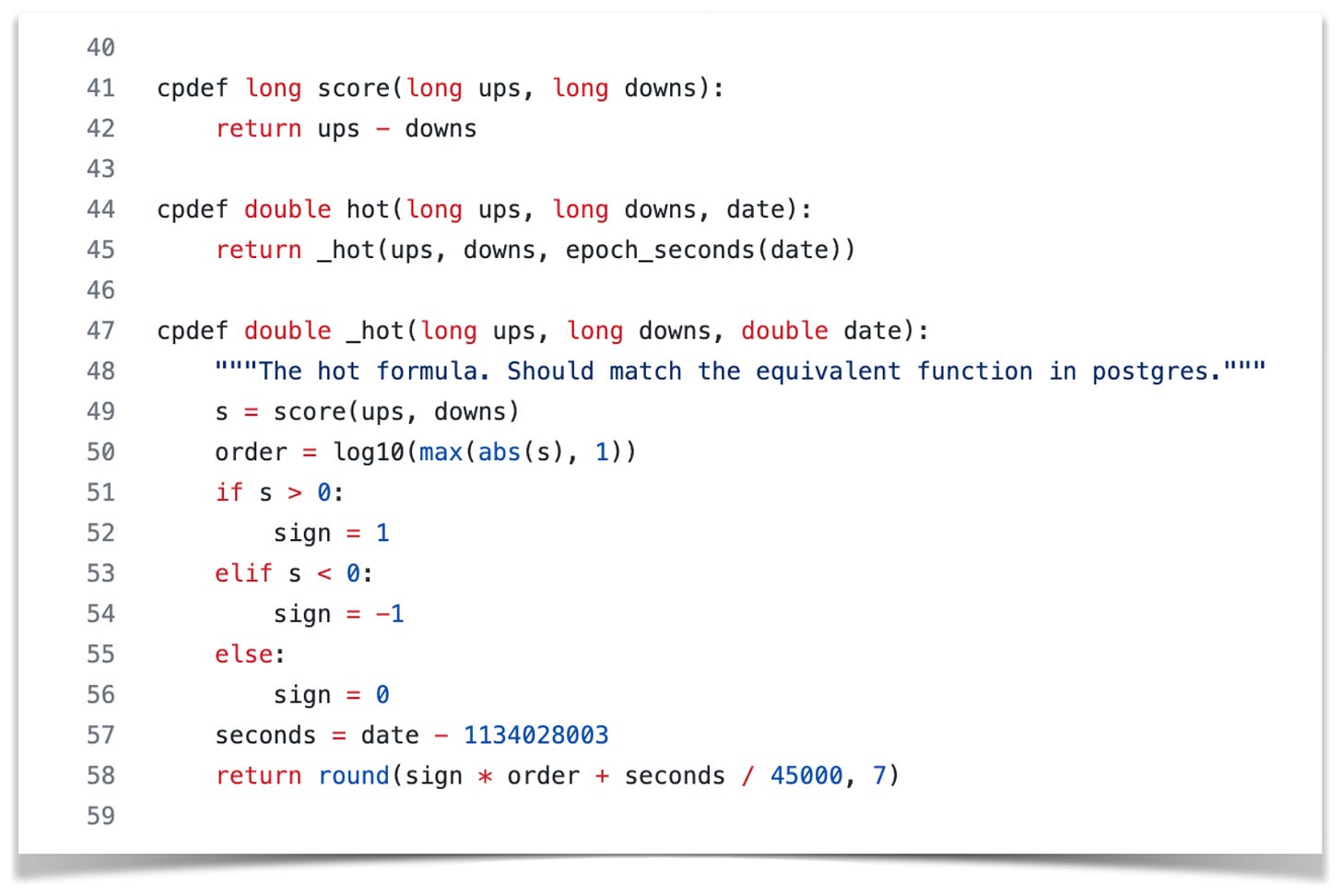
a. Most Likes Wins
The most basic option. Substack uses this as its default.
b. Ratio of Likes to Dislikes
Introduce a two-sided weighing system. Allows users to self-moderate by flagging inappropriate comments with a “downvote” feature.
c. Introduce a Time Penalty
Do we want to immortalize old comments to create an “in-the-moment” feeling? Do we want to prioritize newest comment first?
d. Integrate Noise
An anti-bot measure. Reddit injects noise into their calculations (“fuzzing”) so bots can’t tell if their likes counted.
e. Add Custom Weighting
For example, comments made by higher-tiered subscribers may count more. This is how you “shadowban” or “de-boost” someone.
f. Predict the Future
You can use a statistical measure like the Wilson Score Interval to surface the best comments of the future.
g. Optimize with Machine Learning
You can get as fancy as you like. Recently I read a paper that explored using Latent Dirichlet Allocation (LDT) to calculate word groups then sorting by Cosine Similarity and then running through a Siamese Neural Net (used by fingerprint scanners).
Q4. Web vs Mobile?
Web-first. Why?
Entry Cost. Downloading an app on the App Store is more difficult than navigating to a URL.
Development Cost. Mobile developers are more expensive to hire than web developers.
Cross-Compatability. A responsive website can be accessed on mobile whereas a mobile app cannot be accessed on a browser.
Speed of Iteration. The App Store or Play Store requires approval, which can take 1-3 days. Web deployments are instantaneous.
Q5. What Makes You Different?
I want to be clear. We’re not a “deep tech” company. We’re not trying to reinvent the wheel. Why do we need to..? As Peter Thiel says — “Superior sales and distribution by itself can create a monopoly, even with no product differentiation.”
7. Bonus Q&A
Q1: What’s the role of a Product Manager?
A Product Manager makes trade-offs between the pristine, platonic ideal of beauty that the design team wants, the technical pizzazz engineering desires, the “just give me some shit I can sell” of sales, and the “this may be risky” of legal.
Q2: What’s a PR Company?
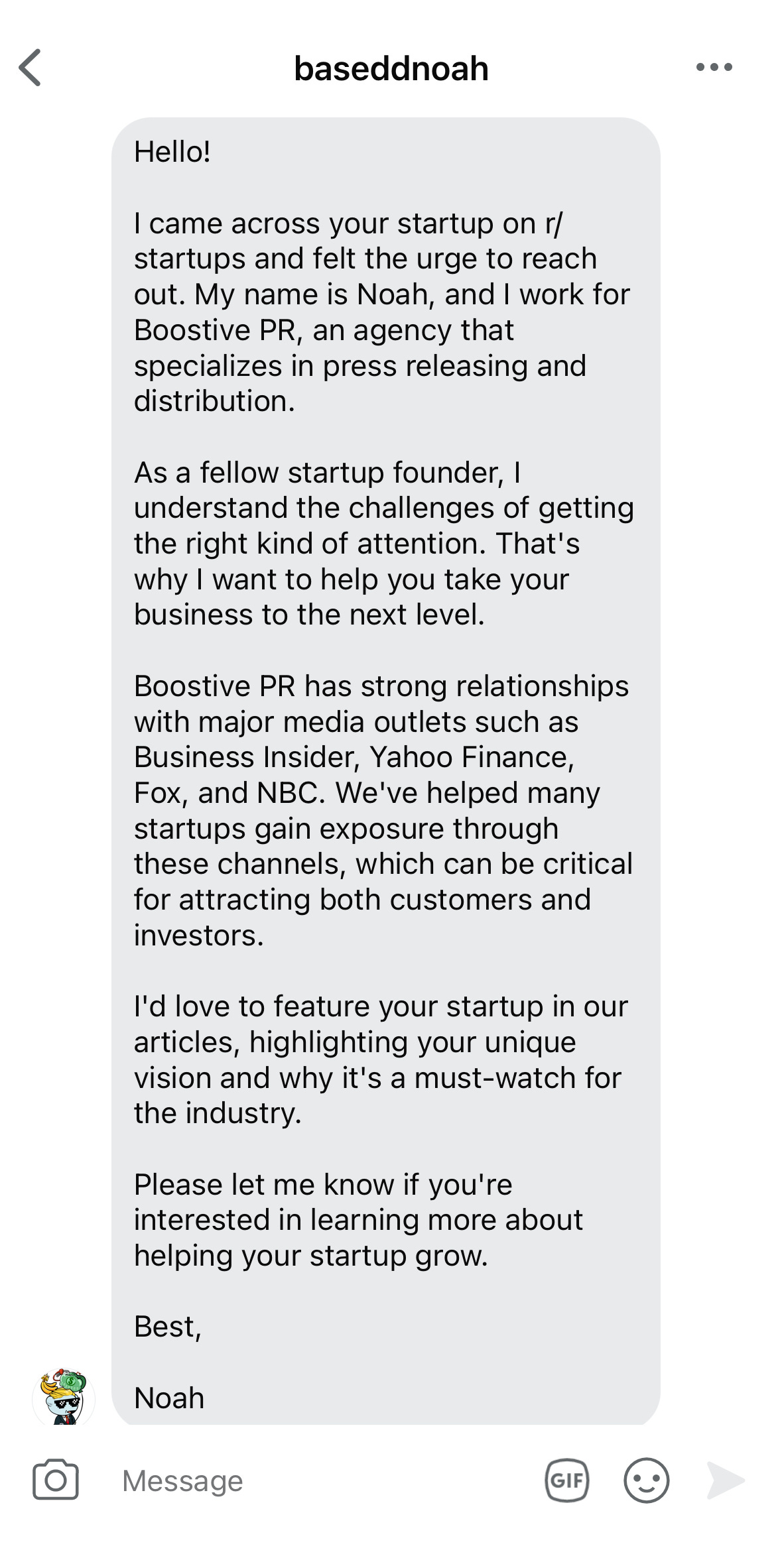
Public relations (PR) are in cahoots with the mainstream press. They will help you get an article in the NYTimes or TechCrunch or wherever you want to publish. As a company, you can choose whether you want to invest in PR. Wish reached an $8 billion valuation with little PR whereas Twitter relied heavily on PR to grow. Generally, a high PR profile helps accelerate recruiting, deal-making and partnerships, and fundraising.
Q3: What’s Design Thinking?
One example is to focus on primitives. They are the building blocks on which an app stands. Examples:
A ride on Uber
An app on iOS
A product on Amazon
A search result on Google
A Zap on Zapier
A meeting on Zoom
A message on Slack
A drink at Starbucks
Primitives can be stacked or nested or gated. Think Notion blocks or Github repositories. Prioritizing primitives (1) maintains familiarity for users (2) reduces friction (3) makes it easy to extend product value over time. Here are the primitives for Reddit, Twitter, Discord, Patreon, and OnlyFans:
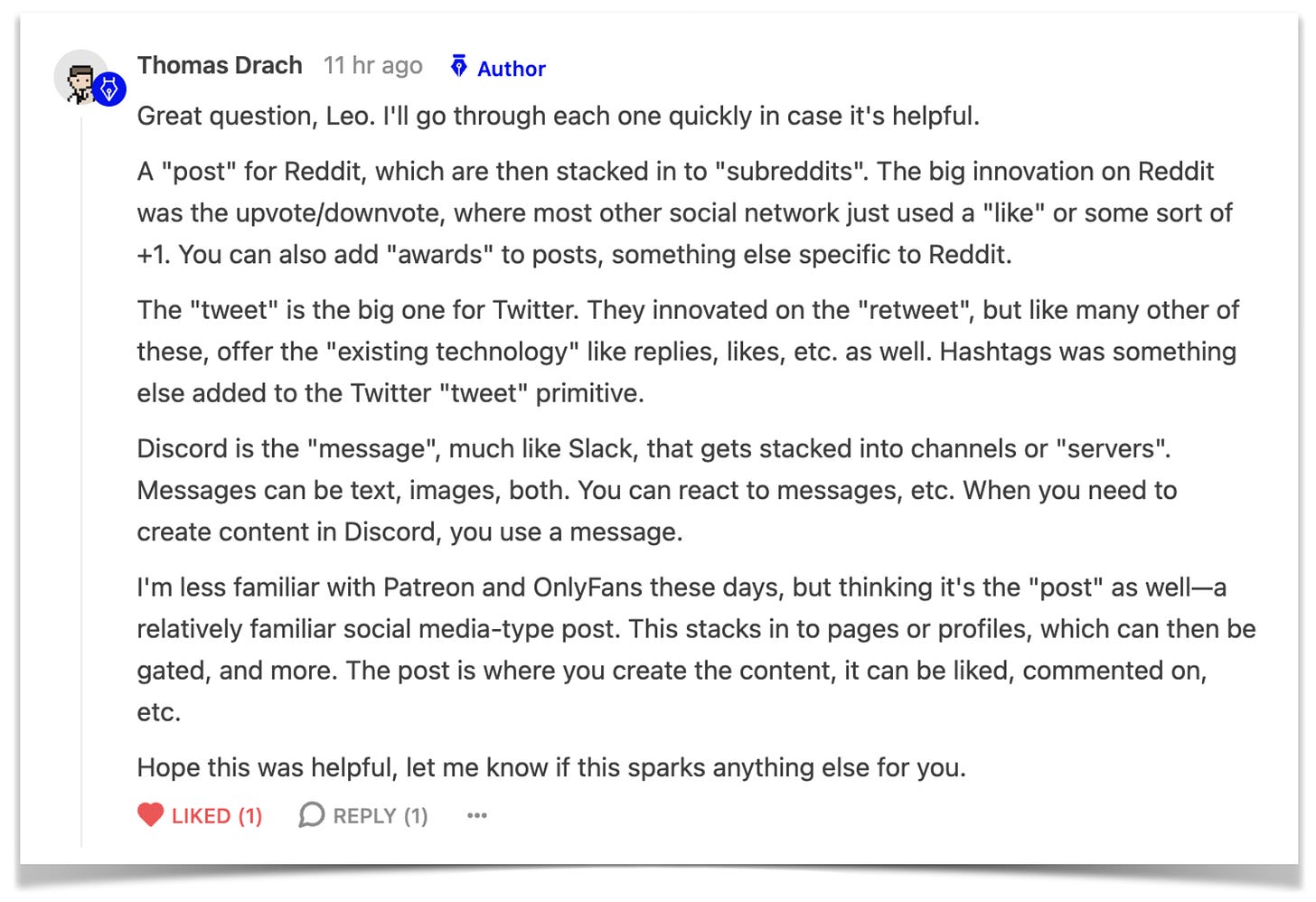
Q4: What’s De-Risking?
Startups are risky. As a founder, one of your jobs is to de-risk the company for future employees and investors. Early-stage tech startups all have the same key milestones. These are:
Hiring employees 1-5. Congrats, you’ve convinced other people to work with you!
First round of fundraising. Congrats, you’ve convinced other people to invest in you!
Product-market fit. Congrats, you’ve convinced other people to use your product!
At each stage, the startup gets progressively less risky to join and invest in. Coincidentally, these are also the hardest goals to achieve.
Please share this article if you found it helpful! I want to show my readers how business is really done. Please do me a favor and help me reach other people who would benefit from reading this!
Have a great week!
Leo A




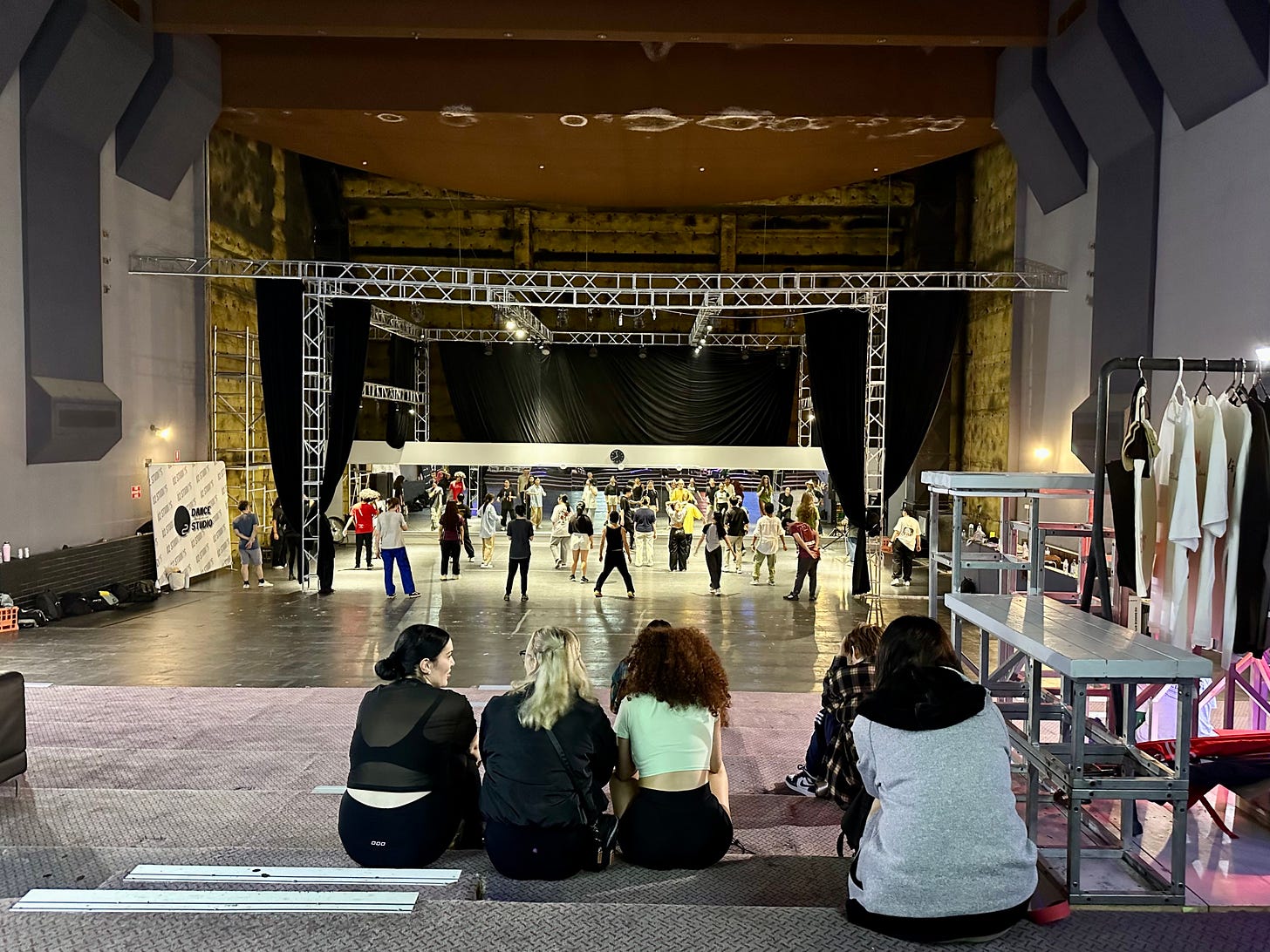
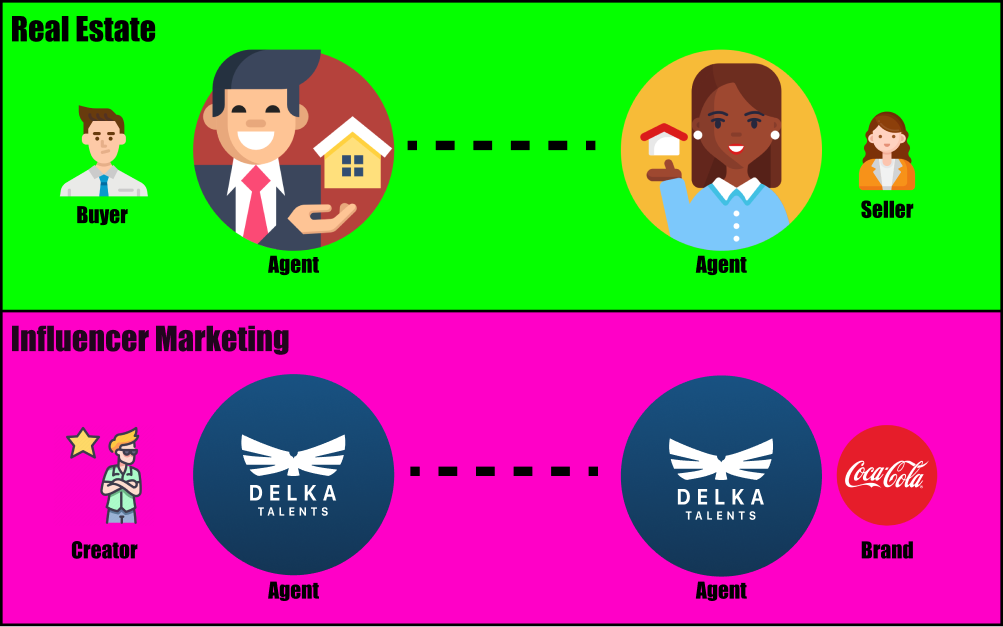
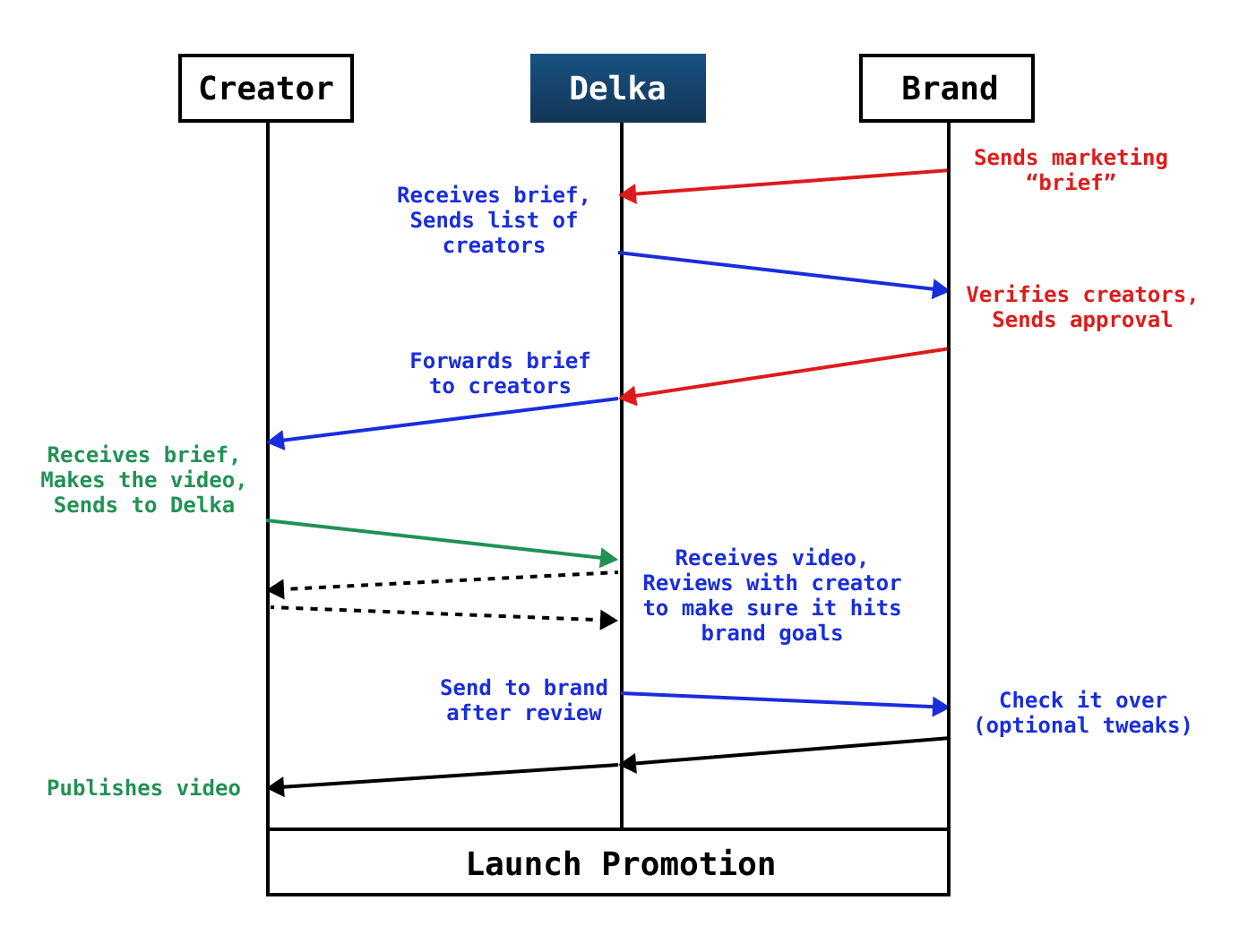
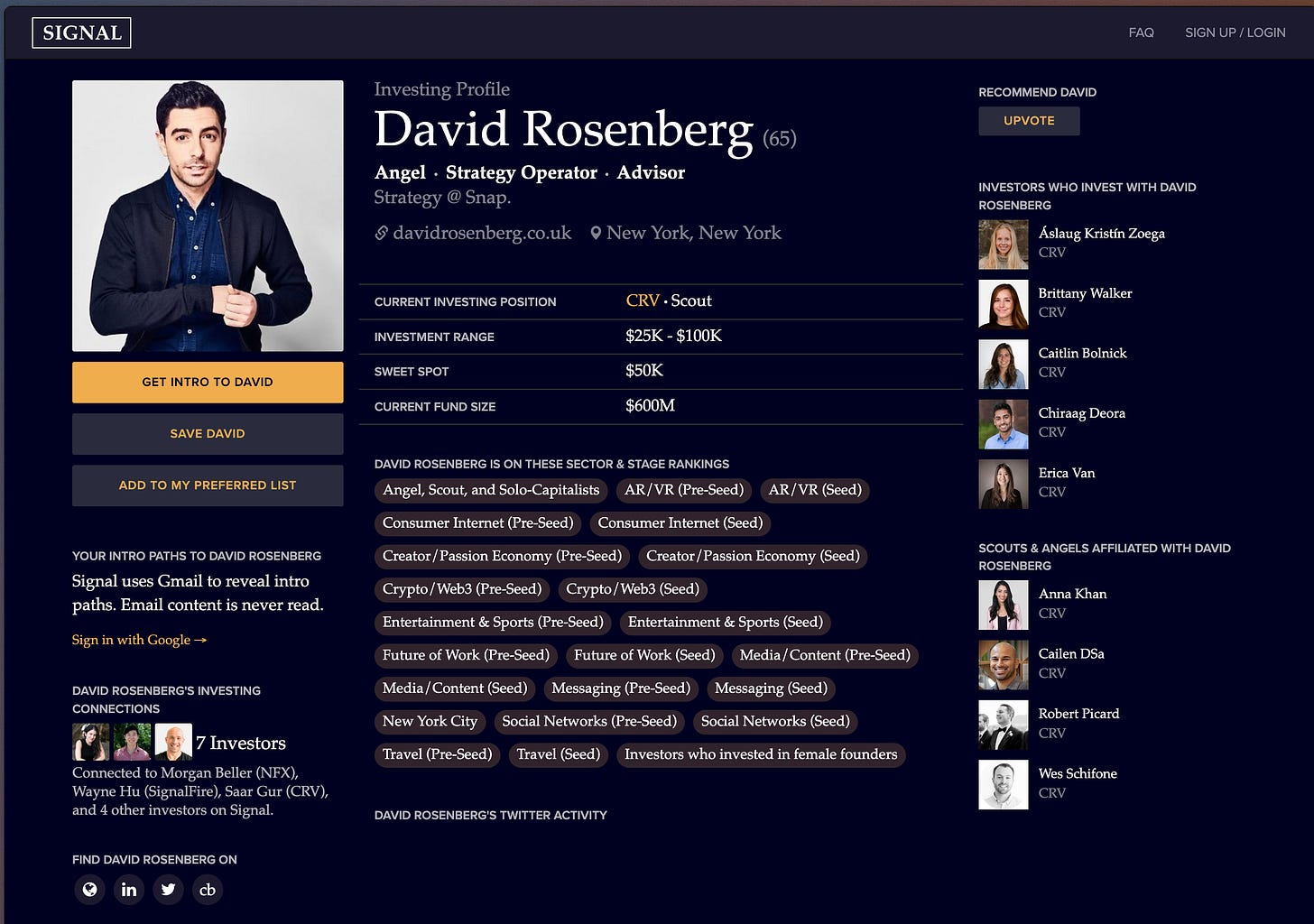

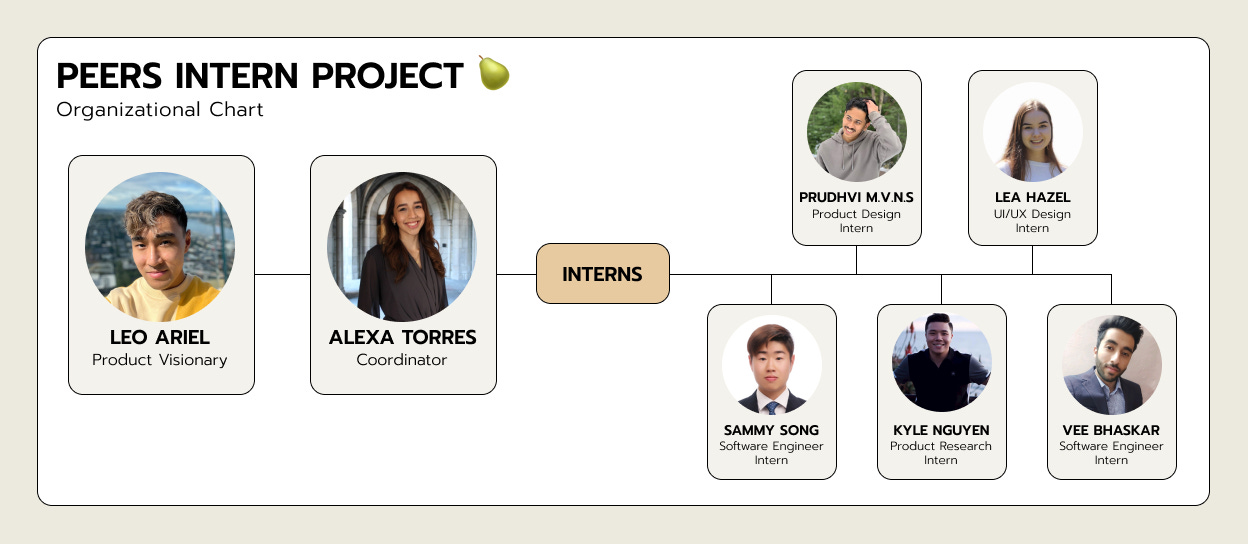
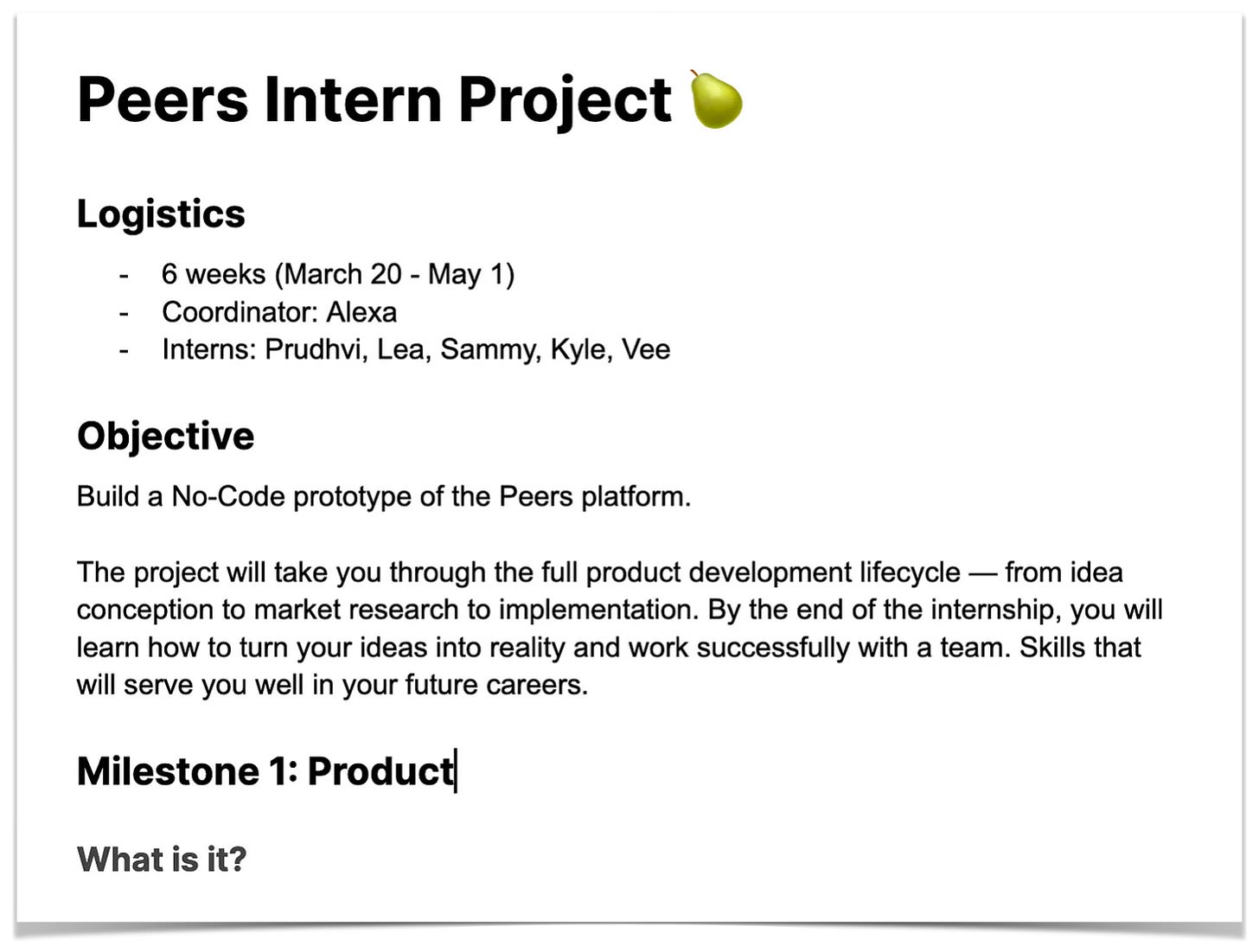
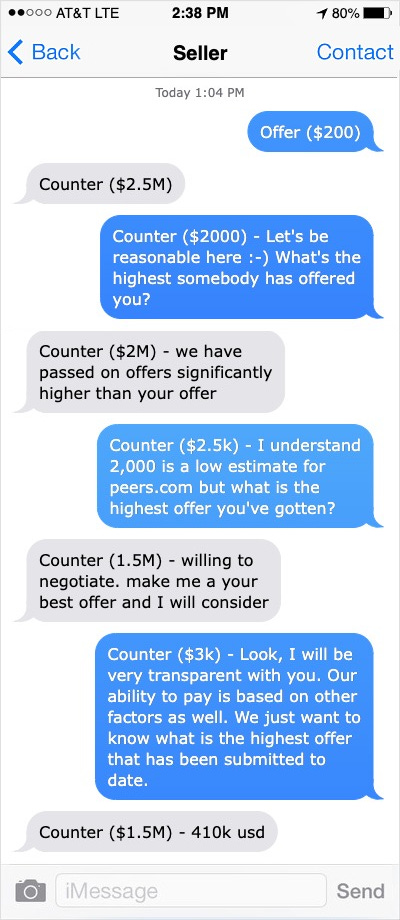
What a detailed read, Leo. I cannot believe that you are headed out to Tokyo so soon. The months fly by faster when I travel vicariously with you!
Great article Leo! Really looking forward to seeing you build this business!!